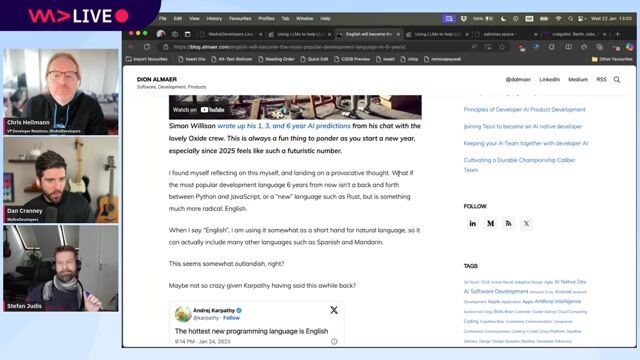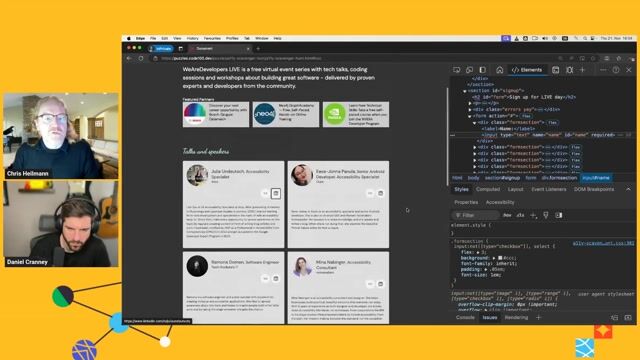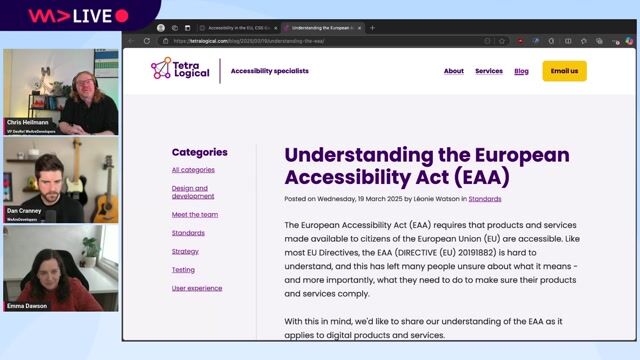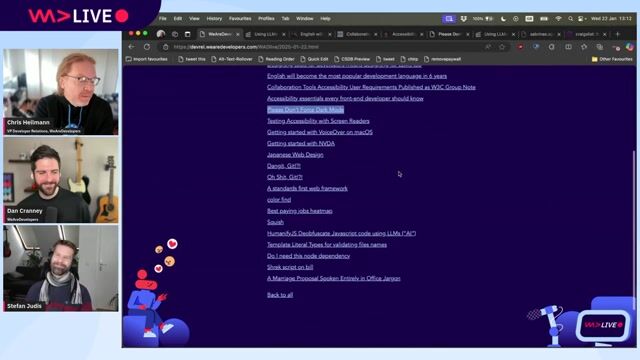Karl Groves
Data Mining Accessibility
#1about 4 minutes
How large-scale data was collected for accessibility research
The research methodology involved analyzing 14.6 million errors from 6 million URLs to establish a statistically significant dataset.
#2about 8 minutes
Common accessibility issues found through automated testing
Automated analysis reveals that 90% of issues fall into five categories, with missing alt text and navigation problems being the most frequent.
#3about 9 minutes
Analyzing the results of manual accessibility audits
Manual audits on representative samples show that keyboard accessibility and color contrast are top issues, with nearly half being high-severity problems.
#4about 8 minutes
The strong correlation between automated and manual testing
Data shows a significant overlap between automated and manual test findings, with seven of the top ten failing success criteria being identical.
#5about 3 minutes
Why testing before deployment is twice as effective
Pages tested before deployment have less than half as many issues as those tested after, proving the ineffectiveness of a reactive audit-fix cycle.
#6about 8 minutes
Applying extreme programming principles to accessibility
Sustainable accessibility is achieved by integrating practices like early automation, specific acceptance tests, pair programming, and treating accessibility as a core quality problem.
#7about 17 minutes
Q&A on developer tooling and testing best practices
The discussion covers developer resistance to in-IDE linting, the causes of false positives in tools, and the need for a layered testing strategy.
Related jobs
Jobs that call for the skills explored in this talk.
Matching moments

27:17 MIN
The importance of web accessibility as a core developer craft
WAD Live 22/01/2025: Exploring AI, Web Development, and Accessibility in Tech with Stefan Judis

24:57 MIN
Adopting a user-centric accessibility mindset
Decoding web accessibility through audit

33:42 MIN
Why you should integrate accessibility early
Going on a CODE100 Accessibility Scavenger Hunt

29:05 MIN
Using automated tools for accessibility testing
Going on a CODE100 Accessibility Scavenger Hunt

40:49 MIN
Finding accessibility checklists and building team empathy
WeAreDeveloper Live: Accessibility in the EU, CSS Gaps and forms with Emma Dawson

39:22 MIN
The challenges of testing with screen readers for developers
WAD Live 22/01/2025: Exploring AI, Web Development, and Accessibility in Tech with Stefan Judis

03:01 MIN
The role of an accessibility lead at Google
WeAreDevelopers LIVE - Can AI save Accessibility?; Horrid HTML; The Frontend Treadmill and more

22:46 MIN
Making accessibility a core part of your development process
Oh S***! There's a New Accessibility Law and I'm Not Ready!
Featured Partners
Related Videos
 35:39
35:39Going on a CODE100 Accessibility Scavenger Hunt
Chris Heilmann & Daniel Cranney
 56:01
56:01Preventing Accessibility Issues Instead Of Fixing Them
Dirk Ginader
 1:09:45
1:09:45WeAreDevelopers LIVE – Inclusion, Accessibility & Automation
Chris Heilmann, Daniel Cranney & Daniela Kubesch
 31:30
31:30Accessibility powered by AI
Ramona Domen
 29:03
29:03Decoding web accessibility through audit
Anuradha Kumari
 23:33
23:33Accessibility Test Driven Development
Maria Korneeva
 29:28
29:28AI is the Future of Accessibility - Karl Groves
Karl Gvoves
 32:00
32:00Is This App Accessible? A Live Testing Demo
Eeva-Jonna Panula
Related Articles
View all articles



From learning to earning
Jobs that call for the skills explored in this talk.








